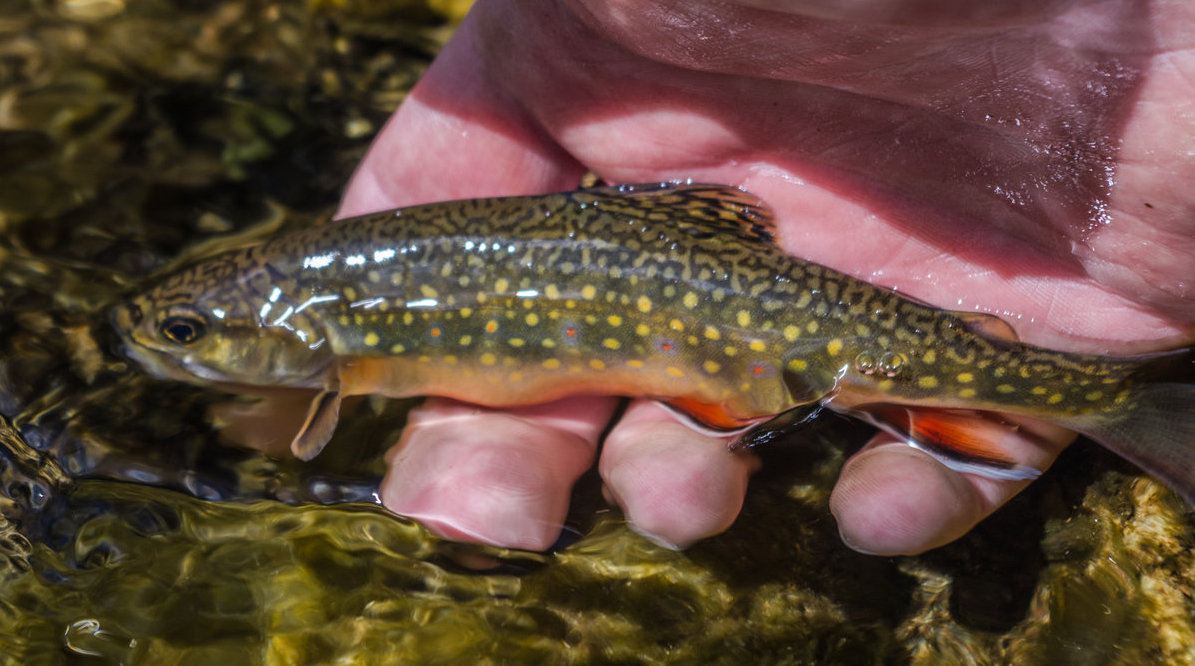Appalachian Brook Trout
The mountains of western North Carolina hold a unique strain of the brook trout known as the Southern Appalachian brook trout. These like all brook trout (Salvelinus fontinalis) are a species of char in the salmon family. Despite the name the brook trout is not a species of trout at all, but is a char related to the Dolly Varden, lake trout, arctic char and bull trout.

The brook trout is a popular game fish that inhabits the eastern United States and Canada. It can be found in lakes, rivers, streams and small creeks, but requires very clean, clear, well oxygenated water with a pH in the 5.0 to 7.5 range. The largest brook trout on record was 33”, but with an average lifespan of just 3-4 years, most specimens do not exceed 12” in length.[3] This opportunistic feeder will eat a wide range of insects, crustaceans, frogs, other fish and occasionally small mammals.[3]
“The brook trout has a dark green to brown color, with a distinctive marbled pattern (called vermiculations) of lighter shades across the flanks and back and extending at least to the dorsal fin, and often to the tail. A distinctive sprinkling of red dots, surrounded by blue haloes, occur along the flanks. The belly and lower fins are reddish in color, the latter with white leading edges. Often, the belly, particularly of the males, becomes very red or orange when the fish are spawning.”[3]
The Southern Appalachian brook trout once enjoyed a wide range throughout western North Carolina, but due to the impacts of acid rain, pollution, over-harvesting, road building, habitat loss due to logging and agriculture, sedimentation of streams due to erosion, as well as threats from introduced species such as rainbow and brown trout; their range has been reduced by well over 50%.[2]
This species can now only be found in the mountainous headwaters and upper stream sections of western North Carolina, Georgia, Virginia and Tennessee.
Climate Change
In the long term climate change is the greatest threat to the survival of native brook trout, as well as other cold-water species in western North Carolina, As other threats have pushed brook trout to isolated, higher elevation streams, these streams are being warmed by the impacts of carbon pollution in our atmosphere, and invasive species that follow the warmer climate.
Introduced Species
Introduced species are also threatening brook trout survival. Brown trout, an introduced species often competes with brook trout, for food and spawning habitat in the waters where they live. As a predatory fish, which can tolerate higher water temperatures, brown trout, as well as rainbow trout, are pushing brook trout out of their natural habitat.
Habitat Fragmentation
Culverts and small dams can prevent brook trout from reaching higher sections of streams that the brook trout spawn in. These diversions effectively isolate the fish to the sections of stream either above or below.
Sedimentation
In western North Carolina sedimentation caused by erosion is the primary cause of the demise of the Southern Appalachian brook trout. Unmaintained trails, roads, logging, agriculture and development can all lead to sedimentation.
Angling – Overharvest
As anglers we can love a species to extinction. The Southern Appalachian brook trout has been over-harvested for the past 200 years in many of the streams that this fish call home. Fishing regulations, such as Wild Trout/Natural Bait stream designations, permit anglers to keep fish that they catch in many of areas where Southern Appalachian brook trout now live.
- Practice Catch and Release, and use barbless hooks.
- Erin Block wrote an article titled At What Price Glory? in the Fall 2013 issue of Trout magazine, that should be required reading for anglers.
- Replacing culverts and dams that fragment streams with fish friendly passage
- Preventing sedimentation by reducing erosion from trails and roads, stabilizing streambanks, maintaining or replacing a vegetated buffer around streams and sensible development.
- Contact your elected officials, let them know your concerns as an angler.
Take care of the fish, and the fishing will take care of itself.
Links and Resources
- Appalachian Brook Trout: Learn more about North Carolina's native trout, which isn't really a trout.
- A Native Son Returns: What North Carolina is doing to understand and preserve our native brookies.
- Davidson River Report: 2003/2017 Habitat Inventories Comparison (PNF/Pisgah District).
- TU Status Report: A report on the TU/USFS Southern Appalachian Aquatic Habitat Connectivity Partnership.

